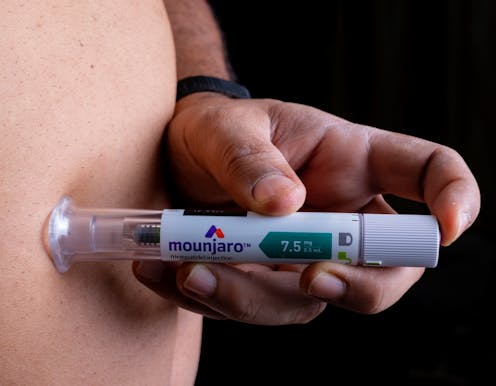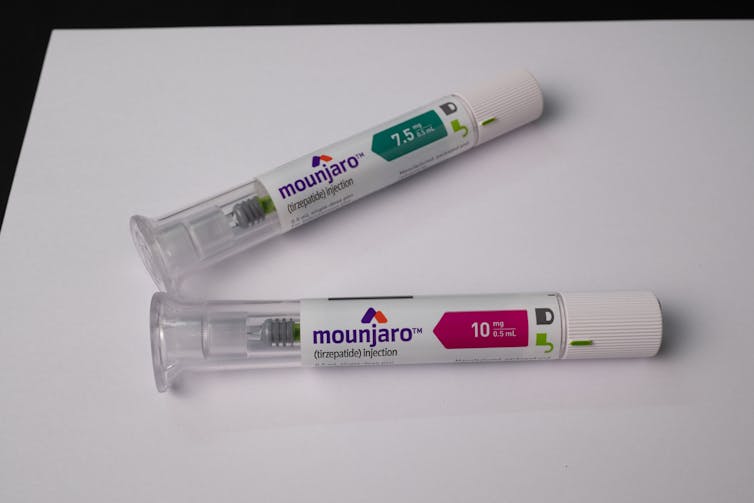
A new drug to treat type 2 diabetes has been approved for use) in the UK. Tirzepatide (sold under the brand name Mounjaro) could be available for prescription by early 2024 – subject to availability.
Mounjaro is an injectable treatment that helps the body to both control blood glucose (sugars) after meals and regulate appetite. Research into the drug has shown it’s more effective in controlling blood sugar and leads to greater weight loss compared with the type 2 diabetes drugs currently available for prescription.
Tirzepatide is derived from a protein with a similar structure to the hormone GIP (glucose-dependent insulinotropic peptide), which stimulates the release of insulin.
But what’s unique about tirzepatide is that it binds to the receptors of another hormone called GLP-1 (glucagon-like peptide 1), which also releases insulin. This makes tirzepatide the first “dual-hormone agonist” (a drug which binds to a hormone’s receptor and activates it) to be approved to treat type 2 diabetes. Semaglutide (sold under the brand name Ozempic) only targets GLP-1.
How does it work?
The hormones GLP-1 and GIP are produced by specialised cells in our large and small intestines, which release them in response to rising levels of blood glucose after a meal.
GLP-1 and GIP both act on the pancreas to increase production of the hormone insulin, which lowers blood glucose. They also decrease production of glucagon, which normally increases our glucose levels when they are too low. Being less able to regulate glucose levels after meals is thought to be a cause of type 2 diabetes.
GLP-1 also slows how quickly the stomach empties, making us feel fuller longer. When combined, all of these have significant benefits in lowering blood glucose levels. These effects have also been shown to lead to weight loss.
The effects of the GIP and GLP-1 that our body naturally produces only last around two minutes. But tirzepatide has modified the structure of these hormones so they degrade slowly and are longer-acting (lasting around five days). This means tirzepatide only needs to be administered once a week.
How effective is Mounjaro?
As tirzepatide mimics the effects of two hormones, it’s perhaps not surprising that research trials have found it to be more effective than semaglutide, which only acts on GLP-1.

A 40-week trial compared 5mg, 10mg and 15mg dosages of tirzepatide (which have all been approved for use) with 1mg of semaglutide. The trial found that all doses of tirzepatide were more effective than semaglutide at lowering average blood sugar levels – with more than 80% of those treated with tirzepatide able to achieve their glucose targets. (It’s important to note here that the dose of a drug relates to the amount that is effective, so dosage levels of different drugs are not comparable.)
A separate year-long study found that 15mg of tirzepatide was as effective at controlling blood glucose levels as insulin.
Another benefit of tirzepatide for people living with type 2 diabetes is that it supports weight loss. Research shows that those taking tirzepatide for type 2 diabetes lost an average of 8.5%-13% of their body weight, while those taking semaglutide lost around 7%.
Around 80%-90% of people living with type 2 diabetes are either overweight or obese. Until recently, drugs used to treat this disease either resulted in no weight loss, or were even linked to weight gain.
Read more: Wegovy was inspired by Gila monster venom – here are some other drugs with surprising origins
Drugs such as semaglutide and tirzepatide, which simultaneously lower blood glucose and promote weight loss, have transformed our approach to treating type 2 diabetes. Weight loss can support the management of type 2 diabetes and can even lead to remission. This is because having a higher body weight, especially weight carried around the middle, can lead to insulin becoming less effective and being produced in smaller quantities.
Tirzepatide can also safely be used alongside other diabetes drugs (such as metformin) if diabetes control targets are not met.
Will Mounjaro be used for weight loss?
With semaglutide moving from being a treatment solely for type 2 diabetes to a weight management drug, many people will be wondering if the same will happen with tirzepatide.
There’s strong evidence to suggest this could be the case. In a large 72-week study involving obese patients without diabetes, those who used tirzepatide lost 15-20% of their body weight. The placebo group only lost 3.1% of their body weight.
Another long-term trial found a once-weekly injection of tirzepatide resulted in a 20% loss of body weight on average, for people who were overweight but did not have type 2 diabetes.
Although no studies have directly compared tirzepatide and semaglutide, these reductions in weight are greater than those reported in studies that used semaglutide.
But while tirzepatide has potential as a weight management treatment, it has not yet been approved for that use in the UK, Europe and US. It’s only currently approved for the management of type 2 diabetes.
Given the supply issues with GLP-1 analogues globally, it’s essential these drugs are prioritised for people with type 2 diabetes. But now that tirzepatide has been approved for use in the UK, it could help reduce the recent shortages of semaglutide.
Duane Mellor is member of the British Dietetic Association
Srikanth Bellary has received speaker fees from AstraZeneca, NovoNordisk, Eli Lilly and Boehringer Ingelhiem and support to attend medical conferences by Eli Lilly and Boehringer Ingelhiem.
Craig Russell does not work for, consult, own shares in or receive funding from any company or organisation that would benefit from this article, and has disclosed no relevant affiliations beyond their academic appointment.
This article was originally published on The Conversation. Read the original article.







